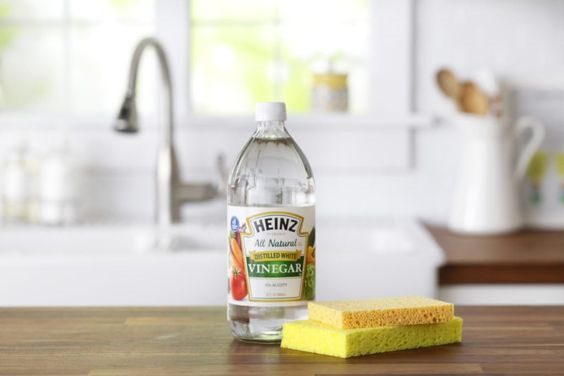White vinegar, also known as “distilled vinegar,” is a moderately acidic transparent liquid often formed by fermenting grain alcohol and is quite useful in cooking and cleaning. It serves as a great way to cut through the grease and grime left behind by the meal preparation process. Manufacturers dilute the acetic acid formed when grain alcohols are exposed to air to concentrations of 5 to 8 per cent by adding water.
Aside from the bitterness or sourness often associated with acetic acid, white vinegar has no distinct flavour or taste of its own, making it one of the simplest vinegar accessible. Because of its acidic properties, it is also useful in the home. It has a wide variety of uses, from cleaning windows and removing calcium deposits to unclogging drains.

Source: Pinterest
White vinegar: How is it made?
Vinegar is a transparent solution that typically contains 4-7% acetic acid and 93-96% water. It’s important to note that white vinegar with an acetic acid content of 20% or more is not safe for human consumption and is instead used in the agricultural and cleaning industries. White vinegar is traditionally made by fermenting sugar beets, potatoes, molasses, or even milk whey.
White vinegar: Purification process
Simply exposing grain alcohol to air can cause it to ferment into vinegar, but this might take a long time and have unexpected results. It may also introduce pollutants like dust or other air particles, which can alter the taste of the finished product, which is why controlled distillation is used more often in contemporary production facilities. Distillation is the process of exposing a liquid to heat, pressure, and different types of air to separate the water and alcohol and facilitate a more efficient conversion to acetic acid.
White vinegar: Variants and substitutes
Although white vinegar is one of the most common and convenient vinegar, it is not always the best choice. Wine vinegar, fruit vinegar, and vinegar manufactured from other grains like rice are also widespread, and many of them may have a white or transparent appearance. You can substitute almost any other type of vinegar for distilled vinegar in most recipes and household cleaning tasks but be prepared for a subtle but noticeable change in taste and aroma.
White vinegar: Uses
Uses in the kitchen
- Toss a cup into the pot of boiling water. The egg whites will set faster and the egg will be more consistent in texture.
- Since distilled white vinegar has no discernible taste or colour, it won’t mask the flavour of the herbs and spices you use to season your pickles. It’s great if you’re doing a lot of pickling because the price is reasonable.
- If you’re out of buttermilk but need it for a dish, you may make do with a mixture of one tablespoon of vinegar and one cup of whole milk. Wait five to ten minutes before utilising it.
- Royal icing is more manageable to eat and sets more quickly if you add a teaspoon of vinegar to it to cut the sweetness. If you don’t have any cream or tartar, the acid may be used as a replacement since it helps to stabilise the egg whites. When building a gingerbread house, this is especially helpful.
Other uses
- Applying vinegar directly to the leaves of the plant you want to get rid of is preferable to spraying it around your yard or garden where it might hit desirable plants as well as the weeds.
- Itchy, scaly ears are a common problem for dogs and cats, particularly if you have a breed with floppy ears, like a retriever. Soak a clean cloth in a solution of white vinegar and water (one tablespoon vinegar to 4 tablespoons water, for example). Next, flip the towel into your pet’s ears to clean the ear canal.
- The shelf life of cut flowers is a topic of much debate. A copper penny is a popular home remedy, while some like to mix in lemon-lime soda or aspirin. Put some sugar and a few tablespoons of white vinegar into the water and see if that helps.
- Pouring one cup of distilled white vinegar down the kitchen sink once a week will keep the drain fresh. After half an hour, rinse it with cold water.
- Because of its versatility, vinegar is often kept in proximity to detergent in eco-friendly launderettes. Use white vinegar to pretreat stains like mustard, ketchup, tomato sauce, grass, and underarm deodorant before washing them away. Vinegar may be used to restore the original whiteness of whites when soaked in it.
FAQs
Is it safe to eat white vinegar?
Wine, cider, and beer can all be used to make vinegar, but grain alcohol is what gives distilled white vinegar its neutral taste. This vinegar has a stronger flavour than most, but it only has about 5% acetic acid, which is about the same amount as other cooking vinegar, so it is safe to eat.
What are the ingredients of white vinegar?
White vinegar is made up of about 5–10% acetic acid and about 90–95% water. This makes vinegar that tastes very clean, crisp, and strong.
How is white vinegar different from regular vinegar?
The main difference between them is how much acetic acid they have. White vinegar, also called spirit vinegar, has between 5% and 20% acetic acid. This is usually higher than the 5%-8% found in distilled vinegar.
| Got any questions or point of view on our article? We would love to hear from you.
Write to our Editor-in-Chief Jhumur Ghosh at jhumur.ghosh1@housing.com |






